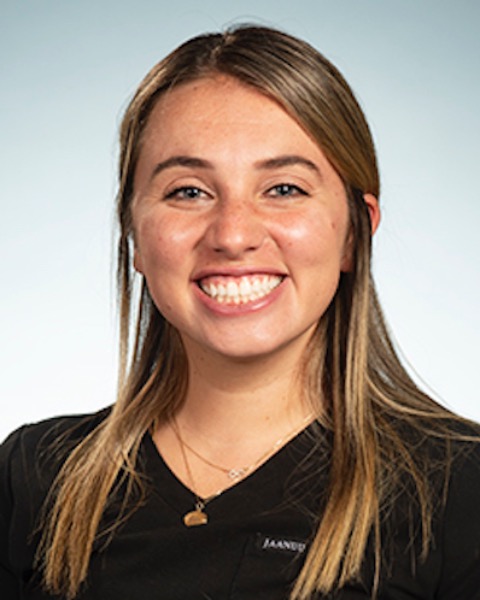ACOS 2024 Annual Clinical Assembly
Plastic and Reconstructive Surgery
Podium Presentation: Metastatic Breast Implant Associated Anaplastic Large Cell Lymphoma in patient with chronic wound, negative cutaneous biopsy and contralateral palpable axillary node: A Case Report

Sarah Tepe, DO
Resident
Redeemer Health
Primary Presenter(s)
Breast Implant Associated Anaplastic Large Cell Lymphoma (BIA-ALCL) is a relatively newly researched pathology with first discovered cased dating back to the late 1990s. The diagnosis is linked mostly to the presence of textured implants. The pathophysiology behind this is thought to be that the textured implants cause an increased inflammatory response within the capsule; however, there is ongoing research studying mechanisms behind the diagnosis including the activation of pathways including JAK-STAT. BIA-ALCL is a T cell Non-Hodgkin lymphoma that typically presents a mean of 9 to 11 years after implantation.
The most common presentation of BIA-ALCL is a persistent seroma that recurs despite drainage. A small percentage of patients (~10-20%) develop a mass or clinically palpable lymph nodes. There are very few reported cases that present with capsular contracture, wound formation or “B” symptoms. Any patient who is diagnosed with BIA-ALCL with sites other than the ipsilateral breast and regional ipsilateral nodes is considered to have stage 4 disease.
Methods or Case Description:
This case report discusses an 80 year old female with a remote history of left ar breast cancer status post lumpectomy and radiation in 1999 and bilateral breast augmentation in 2004 who presented to the plastic surgery office in April 2023 due to concern for capsular contracture of the left breast that had been worsening over the last year. On physical exam, she was found to have grade III capsular contracture on the left. She returned to the office in December of 2023 after working with lymphedema therapy with relative improvement of her capsular contracture, but she noticed a scab form at the inferior pole of her left breast about a month before which caused her to return to the clinic. At that time, on physical exam, there was evidence of grade II capsular contracture along with a 2x1.5 cm partial thickness, ulcerated wound along the inferior pole of the left breast.
The patient was referred to breast surgery and given instructions to undergo bilateral mammogram and left breast ultrasound which were obtained 12/18/2023. Mammogram showed no suspicious findings. An excisional biopsy of the wound was performed. Pathology revealed no evidence of tumor and presence of acute and chronic inflammation of dermis and epidermis with areas of necrosis. She subsequently underwent aspiration of left breast fluid collection on January of 2024. Again, no malignant cells were identified.
The patient returned to the plastic surgery office in February of 2024 due to worsening of the left breast wound despite local wound care and lymphedema therapy. On physical exam, she was found to again have grade III capsular contracture of the left breast. Her wound had progressed to 5x5 cm and was full thickness with capsule exposed. Bilateral supraclavicular, axillary and cervical lymph node exam was negative. Decision was made after informed consent was obtained to take the patient to the operating room for removal of her left breast implant and possible possible capsulectomy with placement of a drain.
On the day of surgery, the patient presented to the hospital and her implant was now noted to be exposed. In the preoperative area, the patient mentioned a newly palpable right axillary lymph node that she had noticed in the weeks since her preoperative appointment.
Outcomes:
The patient was taken to the operating room. Upon incision and inspection of the cavity, it was apparent that the patient had a textured saline implant in place. The implant was removed without issue. There was no fluid within the pocket of the left breast after the implant was removed. There was a modular appearance of certain areas of the capsule raising concern for a potentially malignant process. Pathology was contacted intraoperatively to ensure proper specimens were sent in order to rule out breast cancer recurrence versus BIA-ALCL. The inferior pole of the left breast was sent for pathological evaluation along with a portion of the posterior capsule and multiple portions of the anterior capsule. The patient had no other palpable lymph nodes in the cervical, periauricular, axillary or supraclavicular basins bilaterally aside from previously mentioned palpable right axillary node.
Pathological analysis revealed presence of ALK-negative anaplastic large cell lymphoma involving all specimens. Neoplastic cells were found to be CD45, CD68, CD30, CD43 and Granzyme positive. All immunohistochemical studies were consistent with ALK-negative BIA-ALCL. Molecular study for T receptors were positive for colonial TCR gamma gene rearrangement.
A PET scan was performed on 3/15 which showed FDG avid right axillary adenopathy along with 2 right lower lobe lung nodules and possible lesion superior to right femoral head. She underwent lymph node biopsy of right axillary lymph node and a right lung biopsy. Right lower lobe lung biopsy show absence of malignant neoplasm; however, right axillary lymph node biospy was positive for BIA-ALCL.
Now being followed by oncology for stage four BIA-ALCL. Treatment recommendations are pending.
Conclusion: BIA-ALCL is a rare disease among patients who have undergone breast augmentation or reconstruction with textured implants. The patient in this case had a rare presentation: a chronic wound, capsular contracture and a contralateral involved axillary lymph node. She now will likely undergo systemic therapy for stage four disease.
Learning Objectives:
- Understand the background and pathophysiology of BIA ALCL
- Understand common presentation of the pathology
- Understand the clinical details and picture of a patient with an abnormal presentation
